Showing 11 - 17 of 17 posts found matching: models
Thursday 10 December 2009
I just saw a commercial for Macy's 2009 Cashmere Sale. While I don't care for wearing either goat's hair or sweaters, if Macy's puts their models on sale (even the one playing the "old" lady), I'm buying. Why can't more stores advertise their seasonal specials with unnaturally good-looking women? It seems that there is a shortage of subtle hotness in Christmas advertising these days. Between the uncomfortably overt sexuality of GoDaddy promos and Zales adverts intentionally confusing jewelry with love, it's nice to see that someone remembers that dressing the set with beautiful women is still enough to get consumers to notice the real star: the product. And no, GAP commercials staring prepubescent girls doing their best Punky Brewster impressions don't count.
Comments (0) | Leave a Comment | Tags: macys models sex
Thursday 10 September 2009
In Comics Buyers Guide #1347, published September 10, 1999, many of the industry's top names pushed for the abolition of the Comics Code Authority. They argued that the Code was outdated and needlessly restricted the artistic growth of comic book storytelling.
The Comics Code Authority was formed in 1954 to self-censor comic books in order to save the medium from interference by public/political intervention. The Code included General Standards that were to be applied to all comic books of the time in order to assure the public that comics were safe for children. Samples from the original code's General Standards include
A.5: Criminals shall not be presented so as to be rendered glamorous or to occupy a position which creates a desire for emulation.
B.5: Scenes dealing with, or instruments associated with walking dead, torture, vampires, and vampirism, ghouls, cannibalism and werewolfism are prohibited.
Now, 10 years later, the publishers that submit comics for Code approval have been so dramatically reduced as to make the Code Authority functionally irrelevant. Theoretically, comic books should be at an all-time artistic high. However, for months the entire Marvel Comics universe has been controlled by villains who have blackmailed and murdered their way into power. (Note that the company was just bought by Disney for $4 billion. Crime does pay!) Even DC Comics, one of the only 2 remaining comic publishers who still submits (some) material for Code approval, is now publishing stories in which former heroes rise from the grave and kill their fellow heroes. Batman is dead and his disembodied skull is now being sexually fondled by an undead foe. Ugh.
It appears that rather than opening new artistic horizons for the comic industry, removing the code has simply been a license to publish depravity. Death, gore, and evil abound (and in some cases, such as Marvel Zombies, are sadistically glorified). That's not art, that's pornography. It's exactly the situation that the Code was created to prevent.
Though lacking any teeth for enforcement, the modern Code still dictates, "heroes should be role models and should reflect the prevailing social attitudes." Sadly, I'm not sure anyone is listening anymore.
Comments (0) | Leave a Comment | Tags: comic books disney history
Thursday 11 June 2009
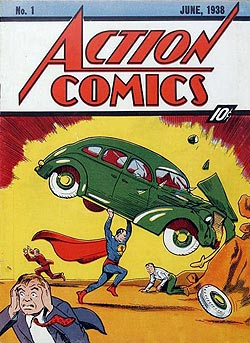
Surely, you've seen this before. Action Comics #1 is the godfather of the modern American super hero comic book. Though not the first comic to feature all-new content, characters, or action, it is the first appearance of a super powered hero (Superman, of course). A lot has been written about this issue and its significance to the American psyche. However, one thing bugs me about most critical analysis: the make of the car.
Most simply reference the object of Superman's wrath a "car" or "sedan." Come now, we can do better than that, can't we? How can we, Americans, with our insatiable lust for the automobile and the goods and evils that accompany it, continue to ignore this perfect marriage between super heroic violence and the American Dream-mobile?
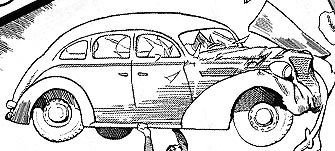
Jerry Siegel and Joe Shuster created Superman sometime in 1933. Although Action Comics #1 was published in 1938, the contents were largely stitched together from panels of unsold newspaper strips. While this means that the automobile pictured inside could be any model sedan marketed prior to 1939, it is most probable that the car depicted was a model year between 1933 and 1938, as artist Shuster likely cribbed the image from a magazine advertisement or photograph in the typical style of the deadline-driven graphic artist. (To paraphrase the immortal words of artist Wally Wood, "never draw what you can copy.")
The car is clearly a mid-1930s four-door touring sedan. They sold spectacularly well, even during the Depression. Every manufacturer made at least one. So which one is it?
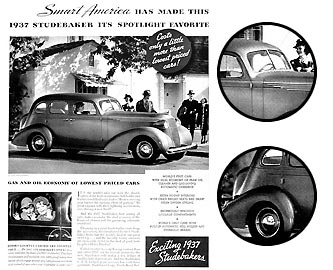
First of all, this car is not a Studebaker. Author Chris Knowles and Illustrator Mark Engblom both make such claims in some otherwise insightful online commentary. However, there's one glaring error with those claims: the car doesn't look much like a Studebaker. The 1934-35 Studebaker Land Cruiser (whose body styling was introduced to the public at the 1933 Chicago World's Fair via a spectacular 28-feet tall scale model) doesn't have suicide doors. By 1936, Studebaker's touring sedans had split-windshields, as became the popular choice of most manufacturers within a year.
So if it's not a Studebaker, what can we see about this car that may tell us which one it was specifically? Three things are worth noting: the single-pane windshield with its curved bottom edges; the angled, horizontally-ribbed grill; and the curve of the detailing above the rear fender.
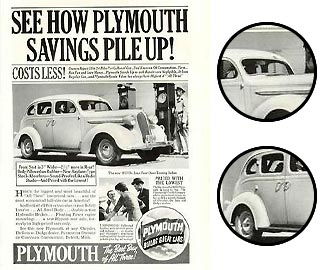
Like Studebaker, Oldsmobile was using split windshields by 1936. Chevrolet's sedans were very square with straight line detailing. Ford marketed Fordor Model 48 sedans in 1935 and 1936, though again, their body detailing doesn't match the car shown. Not surprisingly, most of the manufacturers making touring sedans (Buick, Ford, Hudson, LaSalle, Packard, Pontiac) fail to meet at least one of the criteria established. Yet the 1937 Chrysler sedans appear to be good matches.
Chrysler Airflow 1934 promotional video
Chrysler produced nearly identical touring sedans with the Chrysler, Dodge, DeSoto, and Plymouth nameplates. These models have minor superficial differences, though their general features are all a great match to Superman's sedan. The car in the pages of Action Comics #1 appears to have different front grills in different panels. It is possible that Shuster used different cars for different panels, depending on which angle he was drawing. Maybe he even had a brochure featuring many of Chryslers sedans. (Chrysler was not shy about the cross promotion.) However, after comparison, the 1937 DeSoto touring sedan is perhaps the best match for the grill depicted on the car in Superman's hands on the cover.
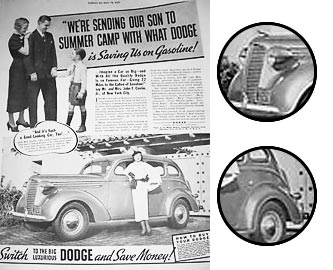
It's worth noting that the DeSoto sedan differs from the 1937 Dodge D5 sedan only slightly in the grill and via the bonnet side-vent panels. Hastily-drawn line-art of the two would be practically indistinguishable. Since Dodge was already advertising "toughness" in 1938 (and had already adopted its now-familiar ram hood ornament), it's quite possible that the car Superman is destroying is intended to be a Dodge. What better way to demonstrate the power of a Man of Steel than to have him destroy something Ram Tough?
So now you know. In any event, Superman hates Chrysler. And when Superman hates you, you don't stay in business.
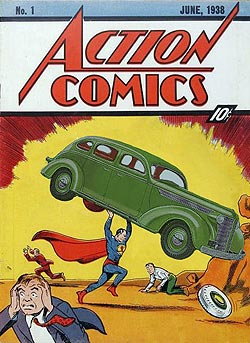
Comments (0) | Leave a Comment | Tags: action comics cars chrysler comic books superman
Saturday 23 August 2008
As a UGA alum, I've received these University of Georgia bookstore catalogs for years. This year, however, in the so-called "'08 Playbook," something seemed not quite right. Sure, there was the obligatory image of Mark Richt sporting his official Nike sideline gear, but the rest of the images seemed a little extra... generic. In addition to all of the models being WAY too old to be college kids, the backgrounds were all wrong. I'm very familiar with UGA's campus, and none of the buildings visible are in Athens. But what really spoiled the charade was on page 7:

Clearly, the people at Follett Higher Educational Group who produced and photographed this year's catalog have never even been to Athens. It's one thing to have a guy showcasing polo shirts and swim shorts featuring Uga produced in Martha's Vineyard (catalog numbers 0950807F $68.00 "Piqué Polo" and 0950807G $75.00 "Surfside Swim Trunks" from Vineyard Vines®), it's another altogether to have him pulling a surfboard out of his 2004 Scion xB in the presumed campus setting of glorious landlocked Athens, GA. Even worse, it's a Surftech Roxy soft top surfboard. Roxy is Quicksilver's line for girls. Good choice, brah.
I can't help but wonder how many other college and university bookstore catalogs feature a similar image with different apparel. You know, we can do amazing things with computers these days.

Comments (0) | Leave a Comment | Tags: catalog fashion uga
Monday 6 August 2007
I live in a town that has a penchant for combining business models for maximum marketability. There is a graphic design sign shop/Taekwondo dojo, a dry cleaners/baptist church, a hot dogs and oysters restaurant, and (my personal favorite) a toy store/lawnmower repair shop. I figure it's only a matter of time before I hear someone ask "you want fries to go with that car title pawn?"
Comments (0) | Leave a Comment | Tags: newnan
Wednesday 11 July 2007
Who is more dangerous: Michael Moore or Al Gore? Both are politically-minded liberals who use technology, one-sided propaganda, and scare tactics to much remarkable success, convincing a large number of people that the status-quo is dangerous to their future. Is Moore's masterful manipulation of the mass media any less deceiving than Gore's ingenious beguiling of the genuinely guileless?
I have friends who are completely in the camps of one or both, and, although even a jaded fellow such as myself has to admit that they do have their points, I am sincerely wary of their means and motives. Is it acceptable to follow a idealistic fool (Moore) or an compulsive liar (Gore), even if they're right? Is doing the right thing for the wrong reasons acceptable?
Once upon a time, Optimus Prime would have told me, "No, it isn't." But my Optimus Prime is dead, replaced by some Michael Bay zombie of CGI scrap metal. And I can't turn to Yoda for answers, because he was recently revealed to be a procrastinating quitter. Even Superman, as of late, has begun to waffle like an anguished X-Man after fathering a child then leaving the woman that he supposedly loves to raise their child on her own so that he can selfishly sow his own wild Kryptonian-oats. I'm rapidly running out of role models here, people.
Comments (0) | Leave a Comment | Tags: al gore politics rant transformers
Saturday 27 January 2007
Now almost all of the things that I have in my apartment are in a box. And I have labeled the boxes. There are at least 8 boxes that feature the word "Batman" in their label. Boxes of dolls, action figures, bedding, clothes, shoes, games, books, playing cards, models, mugs, glasses, bookends, statues, pins, replica movie props, watches, etc. This is after I've already thrown away the things that say Batman that are valueless or damaged, like the aged candy dispensers, empty Coca-Cola cans, Valentine's Day cards, ruined t-shirts, and a toothbrush. No, wait, I kept that toothbrush. And come to think of it, I kept those candy dispensers, too. And... Well, never mind. Eight boxes seems about right.
Comments (0) | Leave a Comment | Tags: athens batman moving walter

